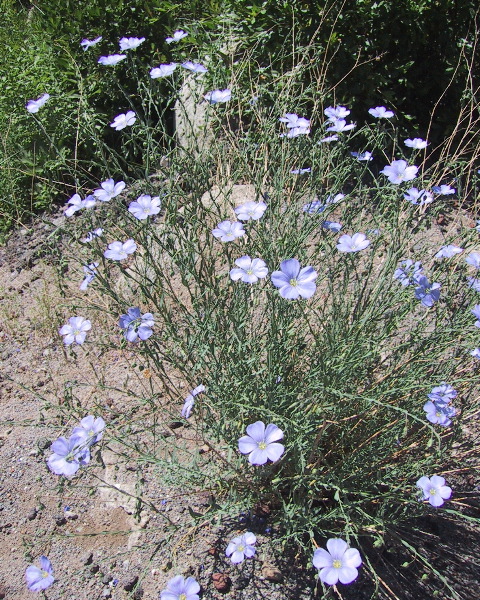Native Blue Flax (Linum lewisii)
By Susan Fernalld, Master Gardener
 Linum lewisii (common name Blue flax) is beloved by most gardeners. Here in the mountains of the west we find the native perennial growing up to 9500 feet (hardy to USDA zone 4). Pale blue to dark blue flowers open just after sunrise and usually close by early afternoon on sunny days, longer into the late afternoon on cloudy days.
Linum lewisii (common name Blue flax) is beloved by most gardeners. Here in the mountains of the west we find the native perennial growing up to 9500 feet (hardy to USDA zone 4). Pale blue to dark blue flowers open just after sunrise and usually close by early afternoon on sunny days, longer into the late afternoon on cloudy days.
Buff-colored seed pods develop after flowers fade, yet the same plant keeps producing new flowers, and a mature plant will have dozens of blossoms open daily throughout the summer. I enjoy a vigorous vase-shaped two-foot tall plant that grows year end and year out in my rocky driveway without supplemental water. For best results, plant Blue flax in full sun and well-drained soil in a warm microclimate. Blue flax seeds survive in areas where soil has been disturbed soil, so it is useful in erosion control.
Because Blue flax stays green throughout the growing season, it provides forage to native herbivores, and it resists fire. Birds use the seed in fall and winter.
Linum lewisii is available at nurseries. To preserve native habitat biodiversity, make sure you choose Linum lewisii rather than a near-look-alike alien plant species, Linum perenne.
Search:
Categories
Archives
Additional Resources
Events Calendar
| M | T | W | T | F | S | S |
|---|---|---|---|---|---|---|
| 1 | ||||||
| 2 | 3 | 4 | 5 | 6 | 7 | 8 |
| 9 | 10 | 11 | 12 | 13 | 14 | 15 |
| 16 | 17 | 18 | 19 | 20 | 21 | 22 |
| 23 | 24 | 25 | 26 | 27 | 28 | 29 |
| 30 | 31 | |||||


